Which office are you? A cold, current 2024 update
The article ‘Which office are you?’ in 2016 was one of the most popular we have ever done on PS. I think largely because it showed clearly how outfits could be adjusted to different levels of formality, at a time when office attire was already changing.
A small change like wearing a shirt rather than a knit, or flannels rather than jeans, can take an outfit from standard to smart. Or the opposite - it can tone down that fancy tailoring you like wearing but you know isn’t really appropriate.
We did an update three years later, in 2019, which showed how different sports jackets could vary an outfit - a horizontal variation rather than a vertical one. And now we’re going back to the original format with two more. You lucky things.
First, today, I’m going through the same process with the kind of wardrobe I wear these days - more brown and black than the classic-menswear navy-and-grey of the original. It is also quite wintry in theme.
Then next week, Manish will come in with a summer version. That will be olive, white and beige in tone: a different set of colours again.
So, the same drill today as back in the original article. We start with a casual outfit and gradually make it smarter, keeping the colours and textures the same throughout, isolating the type of clothing.
Occasionally more than one thing is changed, for the sake of space, but when this happens it’s flagged. Throughout I also suggest alternatives - and am happy to do so more if anyone would like.
1 Pretty standard
The starting outfit: jeans, crewneck and a pair of boots. Where I am, this is a pretty consistent uniform for guys in winter, in an office but definitely not a suit. They chuck a coat or a bomber over the top, depending on the weather.
There’s nothing wrong with this - it’s certainly better than the tatty polo shirt and stretch chinos that dominate elsewhere. But it is dependent on execution: a crewneck doesn’t suit everyone, and you still want colours that work nicely together.
The boots could also be something more casual, like a hiking boot or chukka, or a pair of trainers would be a bigger change.
The starting pieces are:
- Rubato ‘Standard crew neck’ in ‘Earth’
- Rubato black alligator belt
- Vintage black nineties Levi’s
- Edward Green boots, Galway in black calf
2 Dressing it up, a touch
When I speak to friends in dress-down offices, they often want ways to dress up just a notch - not a suit, but something just a little bit more put-together. The obvious way to do that is to wear a shirt - it’s not quite as easy, but the collar is always flattering and the whole is a little smarter. Here the difference between our first two outfits is obvious, I think.
The white PS Oxford shirt shown could easily be something more casual, like a denim or chambray. And that might be better if the jeans were indigo.
The other change here is no less relevant - going from boots to loafers (Edward Green Piccadilly, in black Utah leather). As we talked about previously here, wearing a loafer with jeans rather than a boot or trainer is another really easy way to smarten up, and often one that adds more personality too.
3 Flannels for jeans
Now the washed-black jeans are swapped for charcoal-flannel trousers, and all of a sudden things feel rather smarter. It’s regular law-firm attire rather than something more creative. The fact the change is actually so small, yet the effect big, is testament to how smart black jeans can be.
I’ll be interested in what Manish says next week, but for me there isn’t really a summer equivalent of flannels - something that bridges casual and formal this well. Linen usually looks too casual; high-twist trousers a bit too smart. If there is something here, it’s a particular trouser in the chino/linen area, rather than a whole category of cloth.
The flannels are from Whitcomb & Shaftesbury, in Fox flannel.
4 Jacket for knit
A more dramatic change here, even though the material of the jacket and sweater are so similar, and it’s the same shirt. Tailoring just has such strong associations of smartness.
The tweed jacket is from WW Chan, originally covered here - and rather like oatmeal, it’s a great colour for a casual-but-urban tweed. This is definitely a casual material, but there’s nothing rural about it.
This is such an easy uniform for an office, with the jacket interchangeable for oatmeal or navy, the shirt for blue or pink, the shoes for dark-brown or Col8 cordovan.
The beanie is a cream PS Watch Cap, kind of a smarter version of the baseball cap shown higher up.
5 Add a tie
The last touch. Arguably this is the biggest change of all, given how few people wear ties today. And even fewer do so with a jacket than with a suit.
This particular tie is a muddy green-with-brown-stripe from Anglo Italian: the kind of combination they specialise in. It’s effective at not standing out against the dark pieces elsewhere, despite being silk.
Looking back through the progression of outfits, I realise there’s one less than last time (five outfits rather than six). I think that’s because it started out more casually, with a T-shirt and jeans. That made less sense this time, given it’s a winter theme.
That initial piece is worth a re-read if you haven’t in a while, as it’s often in the asides that the useful advice is found - the virtues of a knit tie, or when a pocket square is too much. Although, I feel pocket squares have almost vanished in the intervening years.
Another option not mentioned above is wearing a collared knit under the jacket, rather than a shirt. I’ve included a shot of that above - with our new cream Dartmoor. I guess it’s a stage that sits between numbers three and four, say 3.5.
So, as we wait for Manish’s version next week, the question I want to ask everyone is the same as last time: which one do you wear? And indeed, has that changed in the last six years?
Thank you to the Anderson & Sheppard Haberdashery for letting us take the lovely photos for this article.


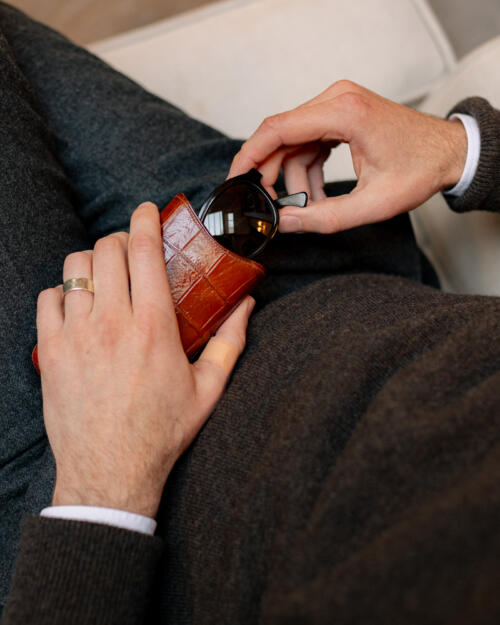
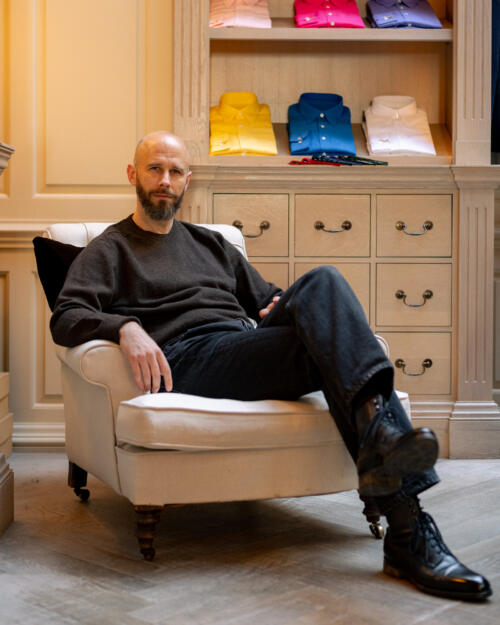
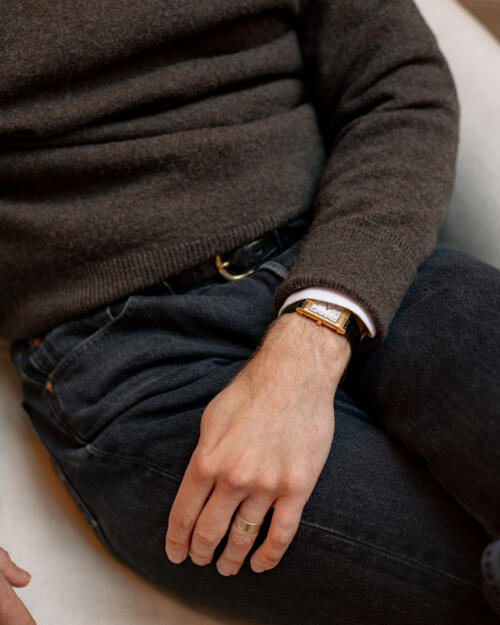
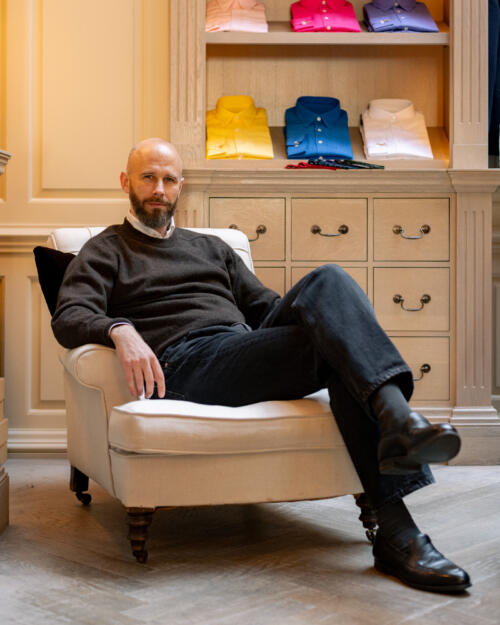
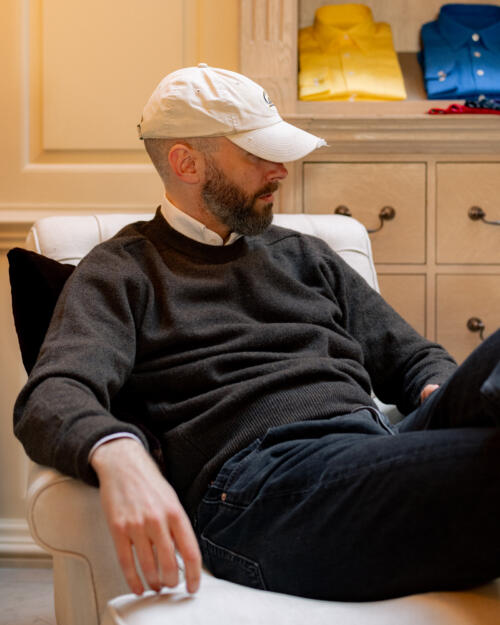
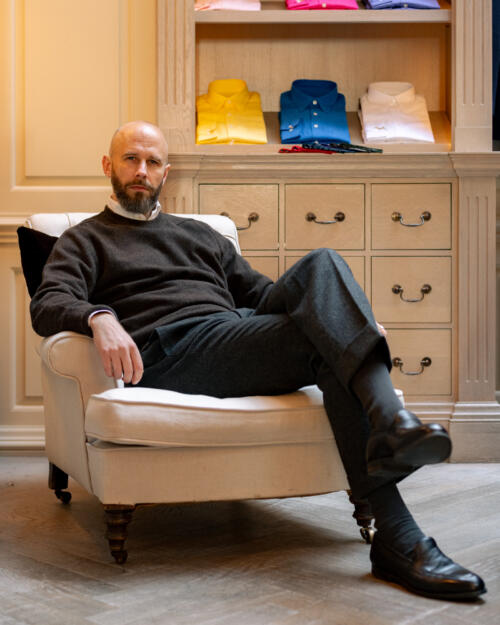
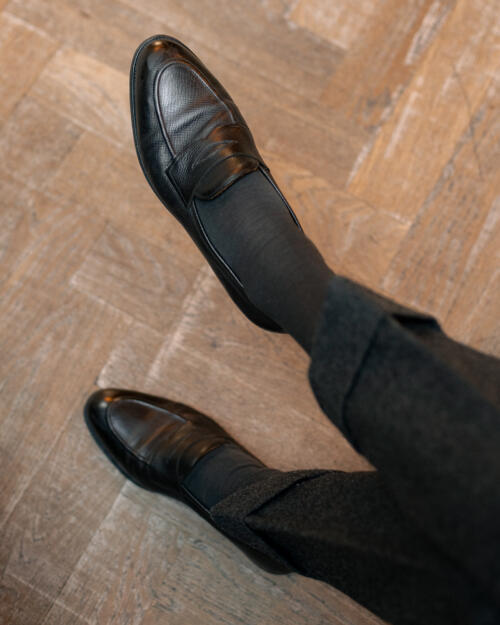
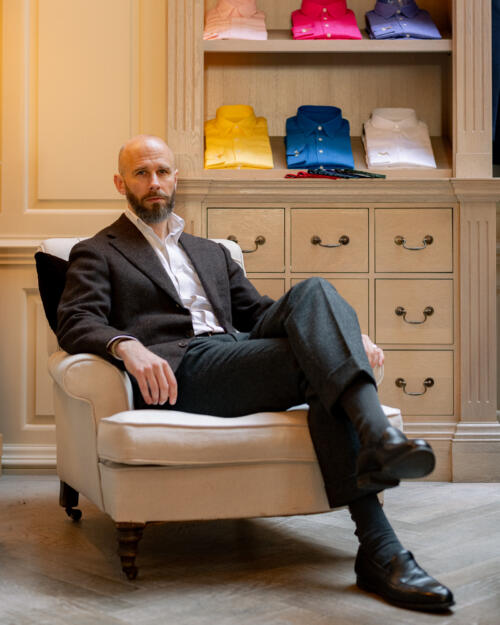
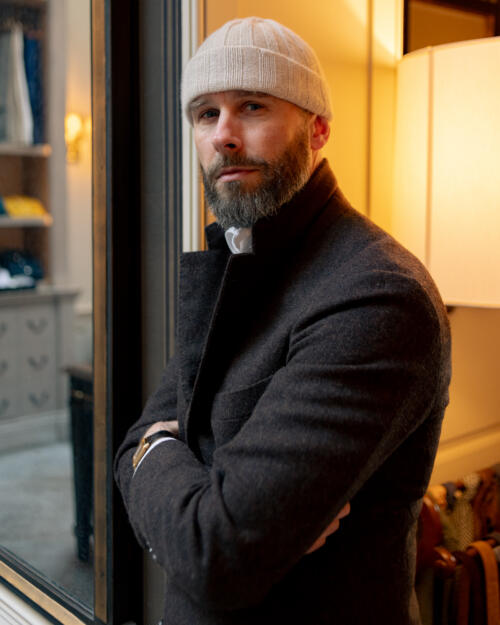
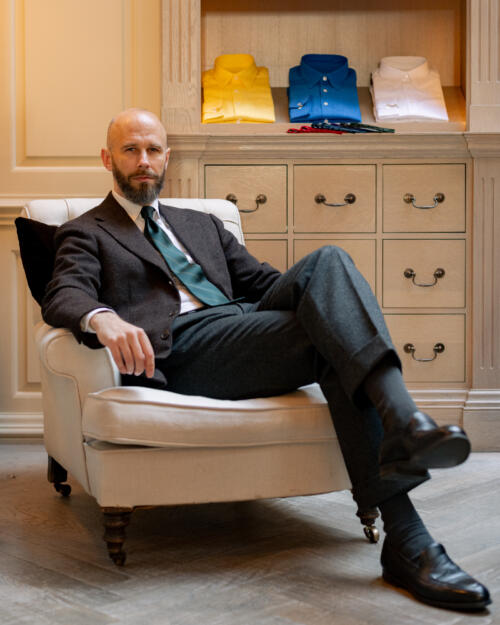
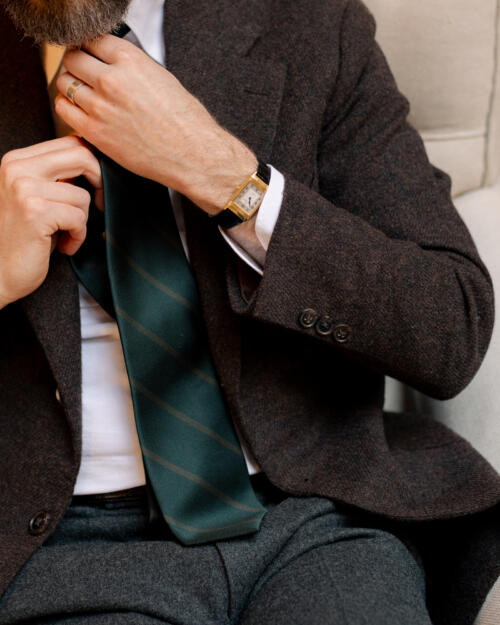
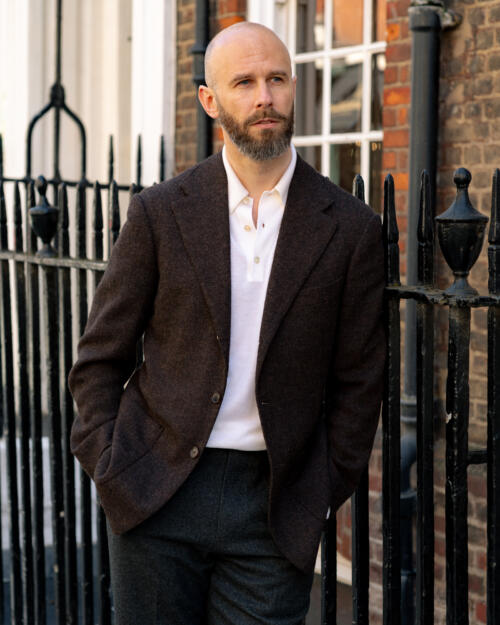



























I definitely dress more casual in the office nowadays. But actually wear a suit with a tie more often. It’s the “navy jacket, grey flannels, light-blue shirt and dark brown brogues” that I wear less often. I wear more black and charcoal, and a more tonal look. I think that the dark cold green chinos (that I think you own) from Blackhorse Lane can be the less wintery trousers that sits between dark olive linen and grey fresco in formality.
Interesting, thanks Carl
Great article Simon – this is one I will be coming back to again and again!
Just a small aside – the 2nd picture for outfit number 1 shows you wearing the flannels rather than denim. Perhaps that was intentional, but I found it a bit confusing at first.
Thanks Nils, good spot. That’s corrected now I think
I’d welcome a similar sliding-scale piece aimed at outfits for the evening. As a dedicated work-from-home-er, with young children to contend with at either end of the day, going out to a nice restaurant, the theatre, party, is certainly my opportunity to be more thoughtful and expressive with how I dress. I dare say other WFHers feel the same! Could be an interesting sibling-article.
Nice idea, thanks Robert.
Second this Simon! Please do a “going out” version which PS readers can use as a guide for night time with the family or with the spouse on a date. Maybe a sliding scale where the end is a night at the theatre (or something equally dressy) but the beginning is far more casual, yet still put-together.
Yes, I second this. Good idea! (And great piece, thanks Simon.)
I think this is a great idea!
These guides which isolate and observe the impact of small changes I find very insightful. Thank you for continuing to experiment with this format as it considers the part to whole relationships which can be quite complex.
Oh good, lovely to hear Chris
I think you’d be unpleasantly surprised if you stepped foot into offices outside of London.
My office ranges from people in tight low rise jeans with trainers and black/grey worsted suit jackets to jeans and a jumper to people taking their shoes off and walking around in their socks or wearing slippers. On occassion I’ve even seen women walking in their bare feet to the kitchen.
Jeans and an orphaned suite jacket is sadly the de facto look for lots of people being a bit ‘smart’ now
I have a few more cotton suits now, post 2020/2021. Prior to that I would only have worn wool to the office. The cotton suits (from Drake’s), just feel and look a bit more relaxed. It’s a nice change.
Number 4 is almost exactly what I wear day to day. The colours might change but the basic combination of softly tailored jacket, oxford shirt, smart trousers (flannels or cavalry twill in cooler weather, high twist or tailored cotton in warm weather) and loafers is fairly consistent. I add a tie when I want to look a bit smarter but don’t wear one day to day. A suit comes out only very occasionally when it’s required. If I want to dress it down, I usually swap the trousers for cords and/or the shirt for a smart polo. Jeans are strictly non-work for me.
For context, my office has no written dress code, although like many workplaces there is an unspoken one. The most common outfit is chinos and a dress shirt (most of them look like they are from Charles Tyrwhitt). Some will add a jacket or jumper. I find number 4 therefore fits in nicely because it doesn’t particularly stand out but feels a bit more polished.
Pre-pandemic I used to wear a suit without a tie most days. That was partly because I had a less developed sense of style and partly because the norm in my workplace was a touch more formal.
Very interesting article, thank you.
When I think about the last 6 years, pre-COVID and post-COVID, the biggest changes in my office (business law firm in Vienna) were the following.
+ Ties, already not really popular 6 years ago, have completely disappeared. Also in court there is a slight trend not to wear a tie, but 90% still do. I’m curious to see how this will develop over the next 6 years.
+ Suits in everyday office life have also largely disappeared. When I think about it, the only people who still wear a suit are older partners over 55.
+ The standard outfit for many is now category 3 and 4 in your article, but category 4 still prevails (in a law firm that is). Category 4 also tends to be worn by those who are interested in clothes, category 3 by those who are more or less indifferent.
I work in Vienna at a Civil Law Notary’s office and I can confirm that the tie is seen less and less. I mostly wear outfit number 4. A problem is, that also the clients often don’t make any effort at all by dressing up for such meetings. Which very often makes me very overdressed im comparison. So there is an argument, that I am actually dressed wrong.
I wouldn’t worry about that too much. When one steps into a Civil Law Notary’s office, one expects a certain degree of seriousness, which goes hand in hand with the formality of the clothing you describe – even if the clients themselves don’t match it. Greetings from a fellow Viennese
You might be right, and I basically told myself the same thing. But on the other hand, my outfit often gets mentioned by the clients, like „wow, the young notary is dressed up well for us today“ or similar funny remarks. This is baffling and annoying to me.
Hello Simon, nice article as always.
What size of Rubato sweater are you using, and also the Dartmoor sweater you usually wear. Thank you.
Medium in both
Thank you Simon
Nailed it here Simon! Combinations work beautifully and a real masterclass on how to work through these workwear challenges.
Love the pop of colour that the tie offers.
Great to see this beautiful and very inspiring article come up again!!!
What challenges me is the many and myriad combinations with so few different items of apparel.
You could have another article like this but varying the theme eg. The casual to smart country look, city look, business look , holiday and even at home or everyday look.
Many variations of a theme!
Thanks Lindsay. Manish’s though, similar, will certainly go into the holiday side
Would the logic be the same if the crewneck was grey (Rubato Stone for example) and the sport coat was a grey herringbone tweed?
Yes, I would only say that the combination of grey jacket and black jeans can be a little bland, having no colour at all. I might want to wear a shirt that was denim or pink, for example, to add some colour rather than just white
I was at a university sector conference yesterday and it was interesting – and somewhat depressing – to see the way that attendees were dressed. As might be expected, the female attendees were often colourful and wore a wide variety of styles. By contrast only three of the men (I was one) wore ties. The others (probably around fifty or so) wore suits. I didn’t see anyone in a a sports jacket. What was depressing was that all of the men were in either navy or dark grey suits and all wore an open necked business shirt, predominantly white, with a few blue in evidence. It seemed dull, unimaginative and uniform in a rather dystopian way.
Interestingly, two people commented on my tie – one male, one female, both positive – a modest striped one. I can’t help hoping that the tie will make a return and provide men with the opportunity to express a little individuality once again.
Think of yourself as privileged. In my field men wear their suit jackets with jeans 🙂
It seems a lot of men don’t know how to wear anything in between a standard business suit worn as a uniform on the one hand or totally dressed down and slobbed out on the other.
Most of us have lost the art of putting together relaxed outfits that carry a bit of panache. What we all need is a Casual Style Guide.
Simon a question on your perception of shoe proportions if I may. Do you think loafers work for men with large feet, like UK 10,5? While lace ups I feel work better as the size goes up, ideal proportions for loafer appear to be size UK 7 – 8,5 and it starts to get a bit awkward from there.
I think they do, yes. I think it’s just that design aspects of any shoe become more prominent, and if a loafer is much chunkier, or has a lower vamp or something, it stands out more. Lace-ups tend to have fewer of these details or be more conservative. Also, how the loafer looks depends quite a bit on the width/length of trousers
Thanks and you are correct, these are the attributes I pay attention to, especially the vamp height, it really must be spot on to work for me as I’m pretty rigid about my trouser width. I also have to be mindful about colour combinations between shoes – socks trousers but thats a given anyway.
Also to comment on the topic. It’s true that there are more situations where you don’t NEED a business jacket anymore and I haven’t been to Meta HQ in California or anything but from my experience throughout Europe, there really isn’t anywhere I feel like I couldn’t wear a jacket or have been uncomfortable wearing one. You can always find a suitable fabric, cut, structure and dress it down as low as you want. Maybe people who used to wear jacket as uniform need to re-learn to wear it as a personal stylistic choice, something they enjoy.
Nicely put, yes
The jeans look great. I like the boots but given the relative slimness and fineness of the rest of the ensemble, I see them as contrasting, but not quite enough for my taste – it would be interesting to see how a hiking boot or similar would look as a high/low pairing. I like my Anglo Italian desert boots for this kind of thing
I really enjoyed this article. Perhaps because it’s similar to how I have updated my own wardrobe. Instead of having “Three shirts” or “four trousers”, now … they are all in various modes of formality: Very casual, casual, smart. The result is a dramatically smaller, but more versatile wardrobe.
At my age (mid 60s), I am trying to embrace societal expectations about age and dress. So, that means in anything but casual settings, I’m likely to be in a navy blazer. I still prefer the classic gray, charcoal, navy palette but pay more attention on matching garments based on formality but still in the same basic scheme.
Well done.
Thanks Bob, and interesting to hear
Hi Simon, great article, could you tell me where the glasses case is from? Thank you
It’s a vintage cigar case, from Bentley’s Antiques
Your jacket looks cool. I want to buy a similar brown jacket as you. Is it still relevant that tweed is inappropriate to be worn after 6pm? Then brown wool+cashmere blend will be the next choice for me. However would it drive the outfit to become way too smart than your tweed jacket?
All the best
Shlok
I wouldn’t worry too much about that rule, other than to bear in mind that jackets should be smarter at evening events. If you’re going to dinner at nice restaurant, maybe. If you’re going to the pub, certainly not a problem.
Yes, a wool and cashmere would be a little smarter
The last outfit is great – that tie works so well in my opinion. Thank you for the update and looking forward to Manish’s content too.
Pleasure Alex
Hi Simon,
Quick question. What size trouser turn-up are you going with at the moment? More generally what is your current view on having turn-up? Those on my current flannel trousers feel a little cumbersome now and having just purchased a new pair I’m pondering, on whether to have a turn-up at all. (Yes I know it’s a first world problem!).
All the best
I still have a turn-up on most things, just not the smarter trousers, often part of a suit. There’s a post on turn-ups here
Lovely outfits throughout, but goodness me outfit 5 is so terrific that I find this piece acting as an inadvertent exemplar of the unrivalled elegance of classic tailored clothing. Even when set against the other undeniably chic and well executed casual outfits, the jacket-and-tie look is just so far above.
I know, I think most people here would feel similarly. There is a satisfaction I get from the simpler, more casual outfits though. The textures and colours in an area where people often take very little effort
What about tebas, overshirts, unstructured blazers and so on? Don’t they sit between knits and tailored jackets?
Absolutely – there are lots of points in between these outfits we could highlight. Manish will highlight one in his installment too
Simon,
I’m number 2 dressing it up a touch. Office rules are that we must wear a collar shirt. Unfortunately, I stand out as over-dressed and get comments to that effect. I work in an office of nicely paid IT professionals but if they could wear pajamas all day they would! I spent time, effort and money building a modest wardrobe therefore I wear flannel trousers, lace-up shoes, and sweater/jumper over button-up shirt to the office. Oh well, I roll with the punches and certainly won’t change my style, but I am the only person in an office of 25 middle aged men (I’m not a supervisor) that dresses with intention.
Everyone else wears stretchy cargo pants, Under Armour short-sleeve polo shirt and sneakers. The last thing they want to do is put any effort to look professional. Anybody else have that situation?
Best,
Robert
Yes, I certainly do. I work at a university where almost no men make any effort at all with their appearance – and the female staff aren’t much better. I suppose it’s due to the dress-down influence of having so many students and academics around.
I usually wear a shirt with chinos and polished shoes, which makes me look like an eccentric dandy in that context. I never used to like dress codes, but I think we’d be better with one, although some men will manage to look slovenly in anything.
Jack,
Thank you for that confirmation. I sympathize with your particular situation – especially taking care of your shoes, in which I also take pride. I almost feel apologetic/sheepish when I show up to work looking appropriately professional.
The slovenly/careless trend (whether lazy or counter-culture) has sunken to the point it has no where to go but up. If 90%+ of adults/professionals look around and realize they aren’t rebelling or being interesting any more… the next step is to be different by dressing better. Maybe in ten years the act of presenting yourself respectfully won’t be seen as dandy. I fear it will take every bit of those ten years if not more.
Best,
Robert
To answer to both comments, I work in IT, at a university. There is no official dress code, and there seems to be no problem with coming as you like, there’s not any “unwritten” dress code. So I wear suits or jackets/trousers, most days with a tie. I might even pull out a three piece for a day with some special event at work.
Nobody really cares and if they do, the reactions are positive, some to the point where they say “I wish I could dress like that every day but I don’t dare”.
Dario,
Well done! In my case, there are some positive comments… but usually with a stealth snark to them. Comments like But I don’t dare or perhaps But I don’t care. It does get tiring.
Best,
Robert
I work in a university (Professor) and am pleased to say that there is still several members of staff dressing in suits and ties or at least jacket and ties (admittedly this is in a business school, the art and computer departments are a different matter). Several of the senior managers of the University are also usually in suits and ties.
Admittedly, it is a minority of the men overall in the whole university who dress like this but it’s a curious situation (no dress code and lots of staff have been casual for a long time) that the place I’m most likely to see a tie is in a university setting not a business one nowadays.
John
My office is very casual, so I would lean towards 1 or 2. I usually like to wear a shirt, so probably 2.
Simon, I’m curious of your thoughts on a collared shirt under a crewneck. I was reading another style blog recently and they said “never do this!” (instead always v-neck). I find the never’s a bit extreme, and personally find your style quite a bit more interesting and nuanced than the other blog.
Clearly you think it’s ok, since you offer it as an option here. But I wonder about your thoughts on where it falls in permanent style.
Those things do make me laugh.
Yes it’s certainly OK. I can see how some people might think it looked a little more classic or buttoned up, but it doesn’t have to – varying the shirt can easily change that (eg denim, chambray).
A V-neck is great too as a different style, both are good and I wear both. I would only say there that most V-necks are unflatteringly short. Nicer to have something deeper that’s more the lines of a jacket than of an old-fashioned waistcoat.
Hello Everyone.
I can come at the office wearing 1 to 4.
I have’nt done 5 (jacket & tie) for years. It’s hearbreaking because i think it’s still a great look.
What would be for me the “Most Improved Player” outfit is 3.5 => jacket ans knit. I’ve been doing this one more and more for the past 2 years (roll neck or merino polo in winter, short sleeved cotton knit in summer, crew or polo).
Also Simon : Shouldn’t the 3.5 be the 2.5 ? the knit polo seem to me less format than the ocbd shirt.
Thanks for all this great work on PS.
Cheers.
Jean.
Ah yes, you’re right Jean
😊 Even Number 1 is I feel too smart for most of the people in my office (American IT company). Normally men are dressed in sneakers, stretch jeans and round neck T shirt or at best in the worst possible collared shirt.
I am mostly number 2 and if ‘important’ meetings number 3 – even that is sometimes TOO smart.
Kudos for the article.
Number 5 is definitely fabulously put together.
Best
AKG
AKG,
Not sure if it’s specific to America’s IT culture, or same in Europe – but if you are suspected of dressing decently – you are looked at suspiciously or worse yet “You aren’t very technical”. Oh the office eco-systems!
Best,
Robert
Well, I’m in the non-existent category 6 : suits, ties and proper black shoes only at work, which happens to be the legal department of an international organisation. It’s what we call the legal service uniform. Depending on the colleagues, the suits are terrible, decent, good or excellent but that is not the point. The point is that we should stand out because of the excellence of our work, not by drawing attention to oneself and one’s outfit.
Since Covid, lots of colleagues come into work as in outfits 2 to 3, but they do have a suit and tie in the office for unexpected meetings. That’s perfectly fine.
More controversy arises about the youngest contingent of colleagues who think to adhere to the legal service uniform by wearing ‘fashion suits’, i.e. bumfreezer jackets, tight trousers, strange colours, etc. I and others find it sometimes difficult to take them serious in a professional environment.
My point is therefore: rather a casual outfit that does not draw attention to itself and to the wearer – like those in your excellent article – than the wrong suit.
Agreed. Especially on the point of excellence of work. It seems this is lost in so many places. People draw attention to themselves by dressing trendy or slovenly, rather than with understated elegance. Of course, we have some that still do, but they are the few.
Great post
What a nice and useful article. I really like the dark brown througout the outfits, n.1 and 2 with loafers are especially nice. I’m a student and live in Finland so “the office” for me usually means a wool knit, jeans and Red Wing boots. If you were to swap the jeans for cords, what colour would you suggest to go with the brown?
I’d go for black first, as that would be easiest. Then shades of grey
Love this article and the previous office articles, Simon. It is the model that I’ve been striving for at an office where a suit and tie has become rare, but the environment is still smart enough for a sport coat and these looks.
I was curious, do you find the black Utah Piccadilly more versatile than the black calf Piccadilly?
Also, it seems like that WBill cloth is out of stock, although they have an equivalent version available. I had previously been considering Fox’s TD11 (Rosewood Brown herringbone tweed) – do you think your WBill works better in the city (less rural) than that Fox cloth?
I do find I use the Utah more, but it is very dependent on how you dress – I like it because it works with jeans, but with a suit I’d want something in calf.
I haven’t tried that Fox cloth, but looking at it I suspect the Bill might be better, being a little more subtle
I have a jacket (also by WW Chan) in the Fox tweed rosewood herringbone. It’s a lovely cloth. The colour is more muted than the pictures on Fox’s website would suggest – not as red (despite the name) and less “bright” than some of the other Fox herringbones
Very useful article, again.
I liked the 2016 article so much that I helped a friend produce a version of that concept focusing on a (formal) outfit transitioning gradually from very contemporary to increasingly “retro”.
You can see it at: https://www.myvintagelifestyle.ca/post/7-degrees-of-retro
What a compliment. Thank you
This is a great article and an excellent reference. I cannot get over my dislike for the combination of black and brown (a personal preference) but everything else is spot on for me
I agree. There isn’t enough contrast in the black and brown for me. Where the white shirt is more visible in the later outfits it is better. All the pieces are fine individually but the colours don’t work that well together.
Hi Simon, how about the knit polo with jeans? What style of jacket would you wear? 🙂
A tweed probably, or a cashmere with a good bit of texture to it. This brown tweed jacket is OK with jeans, and I just might have a slightly more casual knit polo
Another option for the more casual end of the spectrum is a pique polo shirt, rather than a button down.
You obviously have to get the right one (no logos, stronger collar, not too gauzy). I recently bought a few from Trunk (on Manish’s recommendation) that work really nicely.
I find them slightly cooler than an Oxford button down, which helps prevent overheating during the commute.
I also find they require less ironing.
I slightly begrudge having to spend time in the evening removing creases from shirts, when I’m going to work alongside people just wearing a t-shirt.
Not sure if you have strong views on pique polos in winter, Simon, but I’ve found longer sleeves and darker colours keep them from feeling too summery as well!
I think they can be nice Charlie, definitely. It’s just a little trickier to find a colour, a material and a fit that works well as a substitute for a shirt. Pleased yours seems to.
I’ve always liked their effect under knitwear too – see article here.
Nice, I hadn’t read that article but can totally see it. I’ll have to give it a go when the cold weather returns!
Do you think most people would really notice the subtle differences between outfits 1/2/3 and 4/5? Whenever I’ve experienced with such minor differences the sport coat/suit was always the major change that made people notice while the rest was overlooked.
Depends what you mean by notice – as in, at first glance they may not do, but working with someone during the day, or occasionally noticing repeatedly, I think they definitely would. It’s the kind of small difference that makes someone well dressed, and most people don’t necessarily notice immediately
I would say that most people won’t *comment* between 2 and 3, and a few will notice.
From 1 to 2 I would say it is as big change as 3 to 4, at least coming from a non-formal background
Thank you Simon for the revival of this series of articles.
May I add that the use of the good old „hankie“ or pocketsquare could be a fine addition to the jacket, a subtle but noticeable scale prior to that with the tie. Pocketsquares like those made by Drake‘s can add a touch of colour and freshen things up a bit, without looking to stiff or serious I find. Also, speaking of handkerchiefs, I wonder what your thoughts on a foulards / neckerchiefs are as an alternative to a tie ?
Thanks Jean Pierre.
Personally, I feel like pocket squares stand out a lot these days. They can be a nice alternative to a tie, but only if they don’t stand out as much. Very dependent on your environment – I wrote more here on why I wear them a lot less today.
Neckerchiefs or ascots with a shirt I think can be nice on some people, but are too old-fashioned and fancy for me. I wear silk scarves, but more with knitwear as here.
Thanks for updating this article/concept – revisiting past articles is helpful and keeps things from being too frozen in time.
My daily “work-from-home uniform (winter)” is basically:
– cords (various browns/dark greens) and occasionally moleskin or dark jeans
– oxford button down (blue, white, pink, striped)
– chunky shawl-collar cardigan or Shetland sweater
When I’m feeling up to it (usually on days I’ve shaved), I’ll wear a tweed jacket and tie (knit, wool, or ancient madder).
Essentially this is probably a combination of Ivy/British country. I own and love these clothes so I want to enjoy them.
I would almost certainly wear the above to the office as well, though sometimes there are more formal suit-and-tie reasons to be in-person. On those occasions it’s nice to be able to wear some longwings instead of just socks or slippers!
Office #5 for me. I work for a large law firm in the US. I see less ties than a few years ago, but still over half in our office wear ties with their suits or sport coats. Having a few noted ateliers as clients helps keep people in check. With that said, I cannot express how much I appreciate the uniform. More than one of my colleagues has said they feel naked without a jacket.
Where was your location for the photo shoot.
Those brightly coloured shirts on the shelves look very nice indeed.
It’s the Anderson & Sheppard Haberdashery – same as the first shoot
Hi Simon, great article.
Referring back to the 2016 ‘Which office are you?’ article, would you still recommend common projects as the best “dressy trainer” for those working in more casual offices?
Though boots work fine, I still find loafers are a step too far in terms of formality in my particular office.
Thanks
Good question Gaurav.
I think CP in particular has become way too expensive for the quality it is, but the general style is a good one for ‘casual chic’ looks, as is something like a upscale German Army Trainer (see Margiela). I like canvas trainers more these days, but they’re not as smart.
Canvas sneakers, Converse Jack Purcells in particular, are the only sneakers that look right for me, vintage and timeless at the same time.
Of course what you Brits call a plimsoll could be a nice indoor option in office settings that would tolerate such a thing, sort of the loafer/ slipper cousin to the canvas sneaker.
Hi Simon, could you explain why you went away from the leather sneakers (the sort like common project sneakers)? I also rarely see them in your post these days. Would be really interested in this because in my view its easier to get a pair that fits well – not so with a loafers.
It’s an interesting area, because I do see them coming back a bit. But I went into it in my article on Doek canvas shoes
Great article, thank you.
But do you actually wear no 5 (jacket/blazer with tie) these days? I’ve seen more ties on the website lately, but always with suits. I’m asking because while I do like to wear this combo to the office, I often get questions or remarks regarding “important meeting”? etc. and almost feel more “dressed above” others than I do with a tie-less suit on.
I don’t wear it that much, no. I have featured outfits with jackets and ties recently (eg here) but it’s more common with suits (on me and in general) being smarter.
The comments from others I think reflect the fact that that combination is just more unusual than the same with a suit
I’d go as far as to say that wearing a tie with jacket/trouser separates nowadays is perceived as a couple of notches smarter than a tie with a full suit (depending on the suit). I’ve experienced much the same. Obviously City of London centric, but tie with a suit is seen as ‘work attire’ even if on the smarter end, whereas nice jacket and tie with separate trousers and uh, oh! Someone’s got something important or special to attend!
Think you’re right it’s more unusual, but also perhaps looks far more considered. I was asked a month or so back at a work event if I was going to a ‘wedding afterwards or something.’ I was wearing brown cavalry twill trousers and a grey herringbone jacket and an olive coloured tie. I turned up genuinely worried I’d be under-dressed but in a sea of open necked dress shirts tucked into ill-fitting chinos or grey suit trousers with no jacket, I looked like a minor royal and felt a tad silly all day given my fairly junior position!
As a hotelier, who is in transit every 6 months or so, I have found myself wearing a hyper-functional or formal attire. My luggage consists of tailoring and pieces that will serve me on my journey.
There really are no exceptions, that when on-site, I am in a suit with neckwear. I suppose the only time it changes is if it were a blacktie event, when I will need to up my formality even further.
During one of my first internships, in London, I was in a more lax enviroment but even then I wore a full suit. The university I went to had a strict dress code, so I was insistent on sticking to it.
This did annoy my supervisor who was a very petite young lady. She was frustrated I was mistaken for the manager, instead of her. She did urge me to dress down, but I refused.
I haven’t changed much since then, with perhaps the exception that I am rarely clean-shaven these days, and will allow the occasional turtleneck.
I believe eventually my future wardrobe will consist of exclusively loungewear or evening attire. Home offices are more and more a reality, and though the hospitality world will always need a professional human touch, it too will be automated in time.
Thanks for this piece, Simon, really great and useful!
Quick question: what would you recommend between a brown tweed like this and a grey herringbone such as your Anthology or Salino? I’m getting ready to commission my first Neapolitan tweed jacket and I’d like to wear it with jeans or flannels but am a bit torn between the two colours.
Thanks in advance!
Either would be good, though if you want a very flexible brown I’d go a little lighter than this. Perhaps grey is the safest
Thank you very much Simon, that’s what I was thinking too: thanks to your advice (and the great resources available elsewhere on the site) I’ve decided to go with a Sherry Tweed grey herringbone.
By the way, here’s something nice: the tailor cut a small piece of the fabric the swatch book, for me to keep and look at in different lights etc. – although mostly to admire and think about whilst waiting for the first fitting. Can’t wait for that already!
Nice to hear Stefano.
Yes tailors sometimes do that, though the mills always hate having their bunches cut up!
really interesting article. I think the alternate to grey flannel could be cavalry twill… if you think Connery in Goldfinger etc…
Yes I know what you mean Vik. I find cavalry twill a bit smart compared to flannel, given how sharp it is, but it is a great fabric
Hello Simon, any chance of the PS cashmere crewneck in a similar shade of brown to that Rubato one?
On the those black jeans, that you have written an article about, it will be interesting to see whether they retain their colour enough to remain smart, rather than fading to grey. I recall they should stay black better than most, so it will be interesting to see how they do.
Nice suggestion Rob. No current plan so it would have to be next year, but I like it.
True, though i do like the grey fade in other ways. Maybe after a few years I’ll have a nice grey pair and get a new black one…
Question – I love the look in the top photo – ie the black jeans and black boots – but would be inclined to try to pair that with a shirt and a casual jacket, because I like that higher level of formality and like wearing jackets. Do you think that would work? if so, with what sort of jacket and shirt? (I’m a university lecturer and most of my colleagues are pretty shabby but I like to dress well and have a certain formality with students without seeming overdressed).
Thanks, Simon. I do enjoy reading this blog.
Cheers Thomas.
I wouldn’t wear boots like that with a tailored jacket myself. I’d go for a loafer, or a lower, softer boot like a slim desert boot or chukka perhaps (I like Edward Green ‘Shanklins’ for example).
Other than that, yes the jeans and the oxford shirt here could work with the tweed jacket.
Thanks, Simon – would you ever wear boots (ie not chukka boots) with a suit or with a tailored jacket?
With a tailored jacket probably, but unlikely with a suit unless it was a very particular style I was going for (eg a slim, even western boot as that look)
Thanks for another one of these, which I always enjoy reading. In your 2020 “If you only had five jackets” article, you characterised the dark brown jacket as casual. Perhaps it wasn’t intentional but the implication was that it might not be appropriate for the office setting. Given the centrality of brown to this article, I suppose it is safe to say that has changed?
I have a dark brown jacket in Ring Jacket’s Calm Twist fabric that I love to wear with grey trousers and black shoes and think it’s plenty smart for a London buyside office. Just hoping it’s not only me there who thinks that way!
I wouldn’t say it’s changed, more that this brown jacket is darker and more muted than the other, and therefore a smarter brown. Browns can vary a lot depending on the colour and saturation
I work in industry, in sales, so I barely ever go to ‘my office’ but I go lots and lots of other people’s. The trend in industry has been slightly different (I think) to other places in that it’s been more of a levelling out. Whereas five – ten years ago the plant manager would be in a suit (usually without a tie) and then the rest of the plant would sort of step down in formality from there, until the plant operators were in corporate workwear, now everyone is in corporate workwear – which makes it really difficult to know what kind of seniority a person you don’t already know is sitting at. I think a lot of the managers think they’re being very egalitarian, but I find it mildly sneaky.
I tend to dress in separates. I don’t like being without a lapel and a collar. Often that collar is a knit, but I usually pick shirt or knitted polo to suit the weather rather than formality. I have more knockabout trousers (cheaper wool ones) for if I’m going to a particularly dirty site or if I’m going to have to climb up and down ladders and things, and I don’t often wear lighter coloured trousers at work for the same reasons. Jackets are generally safe if you’re conscious of not brushing up against things.
I find boots are often the most useful way of toning down formality. I also find outerwear (a Barbour jacket a lot this week) can help, especially if you’re often working outdoors, or in and out of doors.
I think people who bemoan the casualisation of their workplaces often underestimate the effect they can have on their colleagues simply by dressing better themselves. People do notice, and they do start to adjust the way they themselves dress. Ties aren’t coming back until guys who care start wearing them and looking good enough that other guys want to emulate them.
I’m at Number 3, though I can come to the office more casually if I wanted to. I am able to dress the way I want to. Number 3 is also a common weekend look for me when I feel that I need to look more presentable than a polo and chinos but don’t need to dress up. I’ll occasionally wear machine-washable chinos to the office, like today when I had to walk to the office in torrential rains. The nice thing about having a flexible office dress code is that I don’t have to destroy nice clothes in heavy rain.
I’m always interested in hearing people’s solutions for walking in heavy rain.
So, for you…
Barbour and umbrella?
Modern, synthetic, hooded rain jacket?
Standard, beige “raincoat” and umbrella?
…on the feet…
boots, heavily mink-oiled?
rubber “wellies”…
rubber slip-ons over leather shoes?
If it’s helpful Leif, I did this piece on what I wear.
Great piece Simon. I use to wear suits and ties every day. Lace up shoes with a mirror shine. I had over 25 suits. Now I predominantly wear style either 4 or 5 in your example. The biggest change for me is the lack of a tie. I have donated most suits and ties to a local group that helps men with little to no money dress for interviews. I’m the president of a financial firm so I feel it’s important to set the standard. I really enjoy your articles as I’m learning how to dress more casually while still looking smart. Thank you! Cheers!
An outfit with an overshirt or safari-like jacket could fit between the sweater and sport coat
Thanks Mike, yes that’s been mentioned above. Manish has one in this range that’s going to come next week
So for me it’s either a 3 or 4 each day. Although in my office 2 to 5 is on display. With the top brass sticking to 5.
If I have official visitors then 5 is appropriate.
The picture showcasing the Dartmoor is a lovely ensemble. That could easily be just the right pitch of formality and style.
Loved this article first time around, I think that might have been the article that got me hooked on PS. Thank you for thinking to do another one! Selfishly, I’d love to see an even-more-casual version of this for an even-more-casual (tech in NY) office, but I realize that’s not a core part of your readership. As noted in this article, for mid-level employees, it’s hard to wear a sport coat without looking inappropriate so I’m continuously battling with polos and casual shirts, jeans and chinos and sneakers. Keep up the great work Simon!
Good morning Simon, very nice outfits! I wear casual clothes at work (chinos etc), so, more formal attire is a matter of personal choise in my spare time. Dressing smartly has fewer and fewer opportunities, given the sartorial moods of most people nowadays. So, whenever i get the chance i use worsted suits with pocket squares and patterned silk ties. I’m not a fan of sport jackets, i replace them with leather jackets (from Aero) and flannel pants. For the summer, linen pants and cotton shirts. Braces (the real ones) with each oufit, every season of the year. I thank you all for the company and the opportunity for a nice conversation, despite our -sometimes- sartorial disagreements.
…in continuation from the previous… to me at least, it would be gratifying and useful also, if you could make an article about men’s clothing of the 30s and -as much as possible- its transfer to today, its infuence on it.
Ok, thanks Dimitris
Hi Simon, thanks for a great article!
A question about the utah leather, it seems that EG have something called london grain now instead. Thoughts?
Piccadilly | Men’s | 184 Last | Edward Green
I’m not sure that’s instead, it’s different. A bigger grain and I don’t like it quite as much
I wear #2 on days when I only see clients by zoom – with dark brown suede boots or Clae trainers. I most often default to navy blue crew neck and either chambray to be less smart or a light blue and white stripe shirt to be slightly more dressy.
On days when I see clients in person then mostly #4, again I default to navy jacket, fine blue and white stripe for the shirt, and charcoal trousers either flannel or hopsack depending on weather.
Previously I would have worn more suits, now it seems overkill, or at least less imaginative.
If you add homeoffice to Zoom / MS Teams, the outfit could easily be (i) shirt on the top, being the only part the client can see, and shorts an no shoes and no socks in summer, and (ii) shirt and knit on the top and jogging pants and houseshoes in the winter.
As one actor described, I can’t remember who it was (read the article long time ago), to look cool and relaxed in a convertible on film you have to wear a jacket and shirt on the top and shorts – nobody can see – on the bottom, then you are not hot.
I work in a big law firm and you are spot on on how casual offices now are. Wearing a suit on a daily basis is a total anomaly, tweed jackets with a Oxford BD is the way most go nowadays. Ties have disappeared unless the wearer enjoys wearing them, but it’s definitely not mandatory.
I’m 1, 2, 3 or 3.5 which is to say I often wear a blazer for work (tutoring kids and teenagers mainly in my home office) but if I’m wearing a blazer it’s almost always unstructured and worn over a T or polo and jeans (Blue BLA E8s or NW8s or black Ironheart 21oz in the real depths of winter)
The most formal I’d go under with blazer would be an OCBD and chinos. If I’m wearing tailored trousers, they’ll be dressed down with a polo or knit. In fact my first bespoke commission for ages, early this year, was three pairs of double-pleated trousers, two flannels, one tweed, as a way of elevating my (winter) home tutor wardrobe from #2 to #3 without being too formal. (The weather got warmer around the time I collected them so I’ve not had a chance to wear them yet!)
It’s a shame really that now I have the money and the (entry level) knowledge to explore good tailoring, there’s less opportunity to wear it. I’m always thinking about ways to dress down tailoring though so I can wear great pieces without feeling overdressed, working from home.
Great article btw, lots of food for thought.
Cheers Tommy
Interesting article I really enjoyed reading it. I currently work at a research institute somewhere in Europe, where I am the lowest ranked person in the organisation, and when I come to work in casual classics, I look more formal than almost everyone except the director and deputy director. So I don’t feel comfortable wearing a jacket. Keeping up with the changing trends of the times is sometimes unpleasant.
Well Simon, I have a question or a favour to ask. My wife and I are getting married(after 10 years of our city hall marriage) in a church next year. But in my life I don’t really wear a suit even once a year (no event), so I don’t want to spend a lot of money on him. (Instead I’m trying to get sports jackets) But because of my unusual body shape, off-the-rack often doesn’t fit well and I’m afraid to do an MTM and fail. Do you have any advice for me? I find wedding attires these days much more simpler than in the past also, but on the other side wedding is too important an event to wear just a blazer and flannel trousers. Many thanks.
Hey Daniel,
That sounds like a lovely event. I would say you should consider whether any RTW can fit with alterations – these can make quite a big difference and many people don’t bother to do them. Then if that couldn’t work and you need MTM, make sure it’s from a place where you can try on a suit in advance and see the fit accurately, so you have more predictability about the kind of changes you want.
Thank you Simon!
Great article. I’m generally dressed 4 or 5. I work at a university (humanities faculty) so people tend to be quite casual… But I never get any remarks or comments about my attire. I don’t think people really notice, or they just know me as someone who dresses that way, and it has become part of how people expect me to dress, if that makes sense.
For me, the big jump feels 4 to 5, as barely anyone wears a tie, certainly not on an average day with nothing special going. I always wear a tie when I’m giving lectures, and I quite like that. As a student, I always appreciated professors who dressed at least somewhat more formally than students.
Perhaps if people made remarks about how I dress, I’d get self-conscious and stop wearing a tie. But as it is now I feel perfectly comfortable and never really think about what I’m wearing during the day. Of course, in academia everyone just goes about doing their own thing and people have very little idea what my day looks like.
I have commented higher up the thread as well. As someone who has worked in university a long time there’s always been a wide diversity of dress styles. I agree with your general point that even early in my career I started wearing a tie when lecturing and then defaulted to almost always wearing one. I find ties so beautiful and interesting (and often a source of positive comments from women especially).
I ended up with so many ties over the years that I started giving them to new and younger members of staff as an encouragement to wear them. Now I find myself browsing in charity shops as well picking up beautiful silk ties for a £1 or £2 and even wearing them on weekends with sports jackets or to a restaurant.
John
Really enjoyed this, thanks Simon.
Great article, Simon. Working at a University most men stand out if what they are wearing is actually clean.
A question on the flannels. I’m usually very stuck in a ‘black shoes’ with grey trousers groove. If you buying new shoes for your grey trousers how would you rank: black loafers, dark brown loafers, or a dark brown derby?
My default would be dark-brown loafers, as it’s the most versatile, but it depends what else you’re wearing.
There’s a very popular thread on this on this article by the way
I have some dark brown C&J Harvard loafers. Would these work with black jeans
It depends how dark they are and how faded the jeans are – have a look yourself and see what you think perhaps
How would that brown crewneck work with white/ecru denim jeans?
It’s great!
Hi Simon, it would be interesting if you could provide examples of cloths that work a jacketing for business separates.
I have a blue/light navy tweed (w bill) and a grey herringbone (h&s), I will most likely get the brown harris tweed if you reissue it. I am thinking of another one, do you think a grey donegal from alsport would work?
Have you seen the jacket version of this format Nick, here?
The old article was already one of my favourites here.
If you dress for work according to “3 Flannels for jeans” and “4 Jacket for knit”, what would be an ideal work bag? Would a Filson in tan, for example, not fit at all? Would a full leather bag be too smart?
Bags are tricky – a Filson might be good, or a tote bag from someone like Frank Clegg